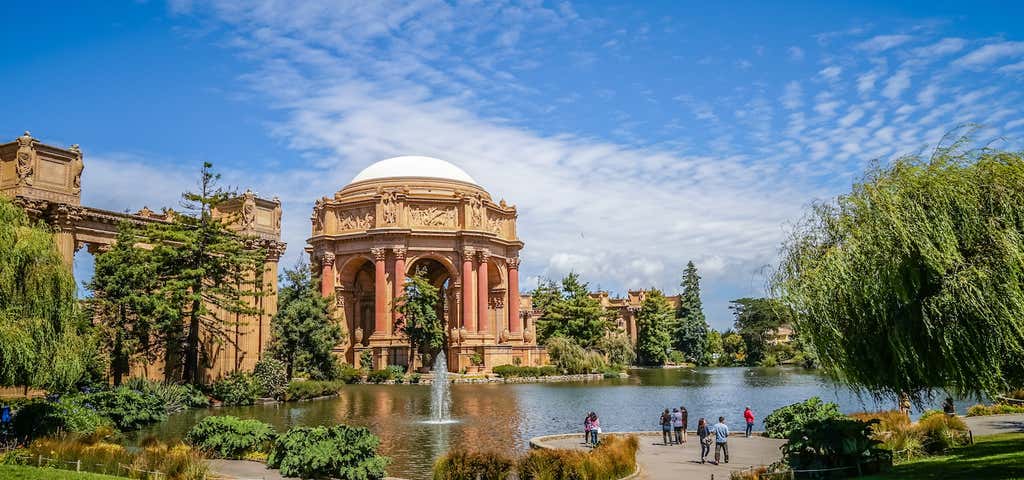People started migrating to California from Asia during the Gold Rush in the mid-1800s, and today the state is home to more than 50 Asian American and Pacific Islander ethnic groups, all with their own languages, cultures, and histories. All over the U.S., historic sites preserve and document the history, contributions, and sacrifices of Asian Americans, from the Chinese Exclusion Act of 1882 to the forced removal and internment of Japanese Americans in the 1940s.
In California, the sites of labor unions, landmark civil rights cases, and significant architecture all tell powerful stories of Asian American heritage in the state and beyond.
The Star of India, built in 1863, is the second oldest active sailing ship in the world. During Alaska's salmon cannery boom in the late 19th and early 20th centuries, the ship was used to transport supplies and workers north from California. Chinese laborers made up an integral part of Alaska's early cannery workforce, but were later replaced by Japanese and Filipino workers after the U.S. enacted a number of Chinese Exclusion laws. Several hundred men, most of them Asian laborers, lived on board the Star of India during the 3-week journey between San Francisco and Alaska. Today, the ship is a National Historic Landmark and part of the Maritime Museum in San Diego.
1
Harada House
In the early 1900s, Jukichi Harada emigrated to the U.S. from Japan and settled in Riverside together with his wife Ken and their son Masa Atsu. In 1915, he purchased the house on Lemon Street, which became the focus of a landmark court case. At this time, California's Webb-Haney Act prohibited certain immigrants, primarily from Asia, from owning property in the state. Harada bought the house in his American-born children's names, and after a 2-year court battle, a Riverside Superior Court judge ruled in favor of the Harada children. The house, a National Historic Landmark, is managed by the Riverside Metropolitan Museum.
2
Little Tokyo
After the Chinese Exclusion Act of 1882 barred Chinese workers from the U.S., Japanese immigration increased rapidly, especially to the West Coast. In Los Angeles, Little Tokyo was settled in 1885 and became the largest Japanese community in the country until World War II and the forced removal of Japanese Americans and people of Japanese descent. The Little Tokyo Historic District is part of a bigger Japanese cultural district in the city, with two pre-war city blocks preserved between Union Church and the Japanese American National Museum.
3
The Forty Acres
The Forty Acres in Delano tells the story of the farmworkers movement of the 1960s and '70s. Here, Filipino laborers played a significant role in gaining and protecting the rights of farm workers in California and the rest of the country. The Forty Acres became the first headquarters of the United Farm Workers of America (UFW) labor union in 1966, and has been preserved as a National Historic Landmark.
In 1942, more than 100,000 people of Japanese ancestry living in the U.S. were forced into 10 "relocation centers" across the country, including Manzanar in California. Two thirds of the more than 11,000 people interned here were American citizens, and many others had lived in the U.S. for decades. The Manzanar National Historic Site was established in 1992 and tells the stories of those who lived and worked at the military-style camp during its three years in operation.
After gold was discovered in California in the 1850s, a small town sprung up in the Mono Basin. More deposits of gold and silver were discovered in 1876, and three years later, the town had more than 250 buildings and 10,000 residents, including several hundred Chinese immigrants, who lived in Bodie's Chinatown. With 110 buildings still standing, the mining town was abandoned in the 1940s. It became a National Historic Landmark District in 1961 and a State Historic Park in 1962.
6
Historic Locke
Located in Sacramento County and built by Chinese immigrants in 1915, the Locke Historic District is "the largest, most complete example of a rural, agricultural Chinese American community in the United States." In the 1920s, Locke was popular for its speakeasies, and 70 years later the town was designated a National Historic Landmark.
7
Walnut Grove Chinese-American Historic District
Located between Sacramento and San Francisco, Walnut Grove was home to Japanese seasonal agricultural workers from the late 1890s until World War II. The town flourished in the 1920s, but became a ghost town after FDR signed Executive Order 9066 on February 19, 1942, forcing Japanese Americans into internment camps. Today, the historic district—built for and by the Japanese community—appears nearly frozen in time.
8
Isleton Chinese and Japanese Commercial Districts
Isleton was founded in 1874, and was home to more than 800 Chinese residents who worked in agriculture. After the Chinese Exclusion Act of 1882, the number of Japanese immigrants to the West Coast increased, but World War II ended the town's heyday. Today the area consists of Art Deco and simpler buildings and gardens from the area's boom period (built after a 1926 fire).
9
Niles Canyon Railway
Niles Canyon Transcontinental Railroad Historic District is located north of San Jose, between the towns of Sunol and Fremont (Niles). Considered “one of the most significant engineering achievements of the 19th century,” this rail line was built mainly by Chinese laborers. It was the final segment of the Transcontinental Railroad, which connected the Bay Area to the rest of the U.S. The well-preserved section still maintains original 19th and early 20th century features like a narrow railroad bed and sharp turns. You can ride a diesel or steam train through the canyon—open on Sundays from February to October—to learn more about this historic achievement and the people who built it.
The Hakone Historic District is home to the oldest Japanese-style country villa in the Western Hemisphere. Located near Saratoga, California, it’s an easy day trip from San Francisco. In the early 1900s, art patrons Oliver and Isabel Stine hired architect Tsunematsu Shintani and landscape architect Naoharu Aihara, both Japanese natives, to build a summer estate inspired by their travels and passion for Japanese culture. Today, Hakone is maintained by a non-profit organization, and visitors can explore the property’s four Japanese gardens, historic buildings, houses, and other structures.
11
Angel Island Immigration Station
Known as the "Ellis Island of the West," U.S. Immigration Station, Angel Island is part of Angel Island State Park located in the San Francisco Bay. First used for military purposes, the island processed up to one million immigrants, mainly of Asian descent, between 1910 and 1940. Detainees endured prison-like conditions and many carved Chinese poems into the walls of the barracks, still visible today, during the Chinese Exclusion Act. Visitors to the island will find the U.S. Immigration Station Barracks Museum, which offers guided tours of the barracks, as well as a visitor center located in the former U.S. Quarantine Station.
The Presidio of San Francisco
During WWII, the Presidio was headquarters for the Western Defense Command, which was responsible for the forced removal of 120,000 Japanese Americans, and others of Japanese descent, from the West Coast. A school for teaching military personnel Japanese was also established at the Presidio, which later became the Defense Language Institute Foreign Language Center. After two centuries of military use, the Presidio of San Francisco is now part of the Golden Gate National Recreation Area, featuring hiking and biking trails with scenic beaches and bluffs, as well as historic buildings and structures.
Roadtrippers
Roadtrippers helps you find the most epic destinations and detours—from roadside attractions to natural wonders and beyond.
Explore More Trip Guides
Route 66 Leg 2: St. Louis to Tulsa
- 61 Places
- 18:31
- 876 mi
Route 66 Leg 1: Chicago to St. Louis
- 71 Places
- 16:31
- 636 mi
Route 66 Leg 3: Tulsa to Amarillo
- 94 Places
- 18:36
- 867 mi
Route 66 Leg 4: Amarillo to Albuquerque
- 74 Places
- 25:57
- 1,271 mi















